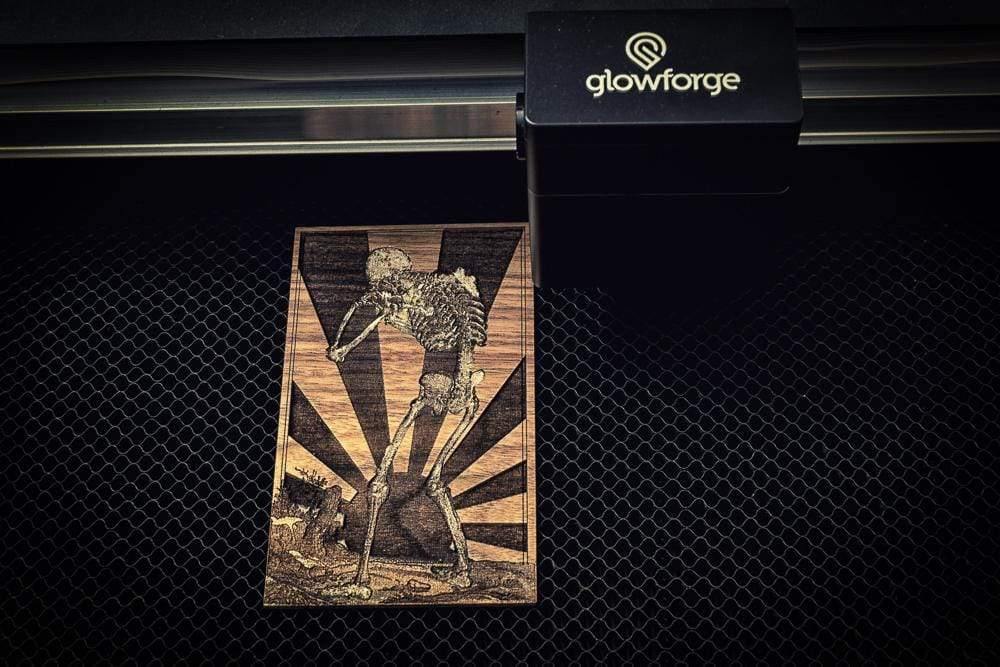
Ten Glowforge Tips and Tricks
Share
-
Worrying about cents will cost you dollars. Trying to forego material testing so as to not waste a few cents of material will cost you dollars in the long run.
Using a material test template like this will save you lots of frustration.
Tip: If you use one material for one type of project a lot, for example you picked up one of our DIY Puzzle Kits, make your test cuts using a representative sample of the design, like this 3x5" puzzle template. -
Use colors in your design software to order operations automatically: The order of operations in the app is predictable based upon the hexadecimal, or base 16, values. Check out the many different palettes that have been designed for different programs like Adobe Illustrator, Inkscape, and Affinity Designer: https://community.glowforge.com/t/custom-inkscape-illustrator-coreldraw-and-affinity-designer-color-palettes-for-ordering-operations-in-gfui/
-
Stroke/Score/Fill - and stroke size doesn’t matter: A vector object (if you don’t know what exactly a vector is, check out this explanation of vectors vs rasters, what they are, and why it matters) can have a stroke and/or a fill. Simply, a stroke is the outline of the object and a fill is filling the inside of that shape with a solid color.
To cut a vector: An object should be assigned a stroke.
To engrave a vector: An object should be assigned a fill.
The stroke and fill colors follow the rules in the tip in item #2 on this list: if they are different colors, they will be separate jobs in the app, meaning they can have different job settings assigned to them. For example, assigning one stroke color a lower power cut (or “Score”) so that it makes an outline of an object but doesn’t cut all of the way through.
Tip: I like to use a stroke size of .008” to simulate the actual size of the beam, especially on intricate designs where overlap may occur. -
Just because it’s an SVG doesn’t mean it’s a vector: I see a lot of people saying that the app refuses to cut, saying bitmaps can only be engraved, but they are using SVG files. SVG files are container-type files - they can contain both raster and vector data. Placing a bitmap object (an image) into a SVG file does not make it a vector.
-
Calipers are important, but not always - because, Set Focus: Knowing your material thickness is important for designing tabs and slots. It’s also important for comparing potential settings between materials; 1/4” plywood is rarely 1/4” - it can range from .180” up to .240”. However, knowing this thickness is not needed for setting an “uncertified material thickness.” Use the Set Focus tool. Click the gear icon, and use the Set Focus option. This will measure the distance from the laser head to the material in a spot that you select.
Tip: Use one or the other. If you are setting the uncertified material thickness, and then using Set Focus, you are doing extra work. Likewise, if you use the Set Focus tool, the uncertified material thickness field will be locked because it’s not needed. The first thing I do on a new job is use the Set Focus tool, and while it’s determining the height, I set my job parameters. This also has the benefit of saving you time since it will not perform the auto-focus scan at the beginning of the job. -
Resolution Matters: If you’re trying to engrave a 500-pixel image you found on the internet at 8x10”, it’s not going to look good. Starting with a high-quality, high-resolution image will always give you better results. Garbage in, garbage out.
-
12x20 artboard: I actually recommend this for a specific reason, even though it exceeds the actual current working area. The software will recognize this aspect ratio when loading the file and know exactly how to size your artwork regardless of the units used (or not used) in the code of the file. Also, a 12x20” artboard will load your artwork in exactly the place that it is in the file - perfect for jigs.
-
Holddown Pins: After you cut your first 3 projects, these honeycomb bed hold down pins should be your very next project. They are worth their weight in gold. Trust me. Your material needs to be flat to cut successfully, and these do exactly that.
-
Oops, you deleted your design and the project is empty: Click the … menu on the app toolbar and select Reset design. This will revert the design to its original state. But, it only works on Glowforge provided designs.

-
Engraving direction: If you can, rotate your design so that the engrave is wider than it is tall (but pay attention to the woodgrain). The rectangle on the right will engrave faster than the rectangle on the left.

